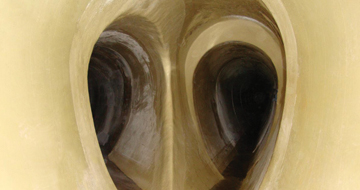
Renovation of a Combined Sewer With Special HOBAS GRP Profiles 930/1510 and 800/1330 mm
In the city of Cottbus in the German state of Brandenburg, the company Lausitzer Wasser GmbH & Co. KG (LWG) makes sure the sewage of roughly 130,000 inhabitants is safely discharged. The sewer network comprises about 900 km of pipes which transport the sewage to eight wastewater treatment plants. One of LWG’s most important tasks is the maintenance of this network. In 2013, a concrete combined sewer from the 19th century needed to be rehabilitated due to severe structural damage and corrosion. It is the main sewer for the southern part of Cottbus and leads through a densely populated area. Because of the channel’s poor structural condition, a rehabilitation with concrete was ruled out. Instead, the investors opted for HOBAS GRP Pipes, which have been repeatedly and successfully installed in Cottbus already since the 1990s.
The longevity of GRP and above all the material’s corrosion resistance was particularly important for LWG. The excellent hydraulic properties also played a major role in the decision process, as well as the low maintenance and resulting cost savings. A rehabilitation of the old concrete channel was not considered, since it would have been very complex, costly, and involved major traffic disruptions. Therefore, it was decided to use customized egg-shaped profiles and insert them into the existing old sewer by means of relining.
The sewers location alongside a narrow and busy road made the construction works quite difficult. Despite the confined space, only one side of the road had to be blocked for the works. In an open trench installation, it would have been necessary to block the entire road. The limited storage space on site made well-coordinated just-in-time pipe deliveries by HOBAS all the more important.
After the calibration of the channel, pipe installation plans with a detailed installation order of the GRP profiles were designed which considerably facilitated the works on site. In order for the profiles to be inserted into the sewer first from one and then from the other side, two relatively small excavation pits measuring 2 x 3.50 m each were built. They were used to lower the new profiles and insert them into the old channel by means of a carriage. Thanks to the relatively low weight of HOBAS GRP Products, the installation went quick and easily. All in all, 140 m of the old concrete sewer were rehabilitated with GRP profiles 930/150 mm and 660 m with 800/1330 mm.
The harsh winter’s unfavorable conditions did not represent a major issue for the rehabilitation works. HOBAS GRP Profiles can be installed without problems even at low temperatures. All necessary lamination works as well as the final grouting of the annular space also went smoothly. The construction works involved the relining of new GRP structures into eight old shafts while conserving the latter. Thanks to the adaptability of HOBAS Products and the construction company’s long experience in the implementation of such projects, all necessary adjustments could be realized quickly and professionally on site.
After completion of the rehabilitation works, the static load is now solely carried by the newly built GRP structures. At the end of the street, the wastewater flows from the freshly rehabilitated pipeline into another sewer that has been renovated with HOBAS GRP Pipes already in 2008. Thanks to the close cooperation of all parties involved, the construction works could be successfully completed on schedule within just a few months.
More information about this application
PROJECT DETAILS
| Project ID: [6512] | |
| Country: | Germany |
| City: | Cottbus |
| Year: | 2013 |
| Application: | Sewer |
| Installation: | Relining |
| Technology: | Hobas |
| Total Length: | 800 m |
| Nominal Diameter DN: | Non-Circular mm |
| Nominal Pressure PN: | 1 bar |
